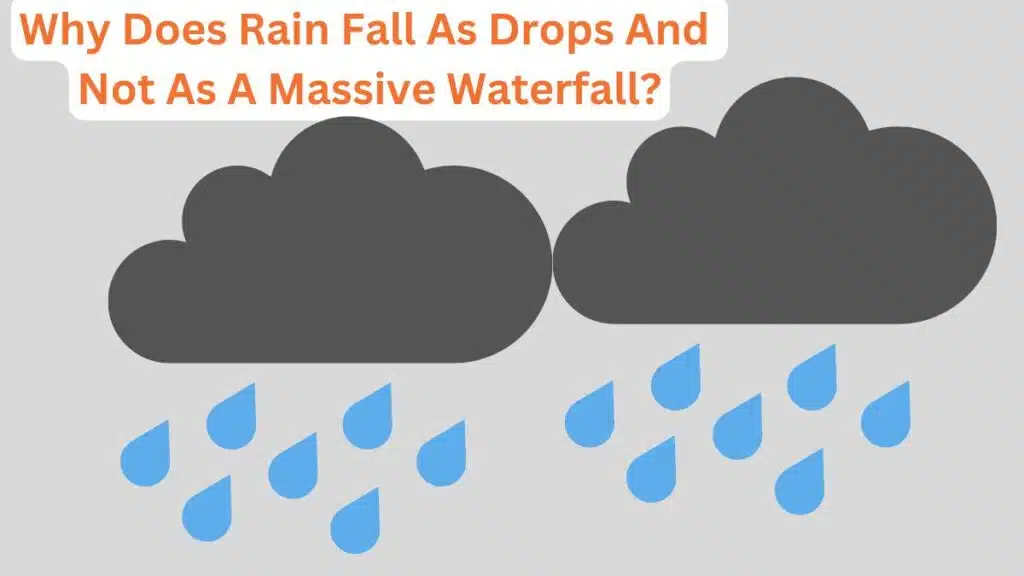Why Does Rain Fall As Drops And Not As A Massive Waterfall?
Rain falls as drops instead of a continuous stream due to a combination of factors. First, the spacing of cloud condensation nuclei prevents them from merging into larger droplets. These tiny particles are spaced apart in the atmosphere, so they cannot come together to form a continuous stream of water.
Second, the force of gravity pulls apart larger raindrops as they fall. This is why you often see larger raindrops break up into smaller drops as they fall to the ground.
Finally, air resistance also contributes to the breakup of raindrops. As raindrops fall through the air, they experience friction, which causes them to break apart.
The combination of these factors ensures that rain falls as drops instead of a continuous stream.
The Water Cycle and Rain Formation
To comprehend why rain falls as drops, we must first grasp the water cycle and the process of rain formation. The water cycle involves three primary stages: evaporation, condensation, and precipitation.
Evaporation
Water from oceans, rivers, lakes, and even plants evaporates due to solar energy. As water vapor rises into the atmosphere, it cools and condenses into tiny water droplets, forming clouds.
Condensation
In the atmosphere, these water droplets collect and merge with other particles, growing in size and forming clouds.
Precipitation
When these water droplets become too heavy to stay aloft, they fall back to the Earth’s surface in the form of rain, hail, sleet, or snow.
Raindrop Formation
Raindrops originate as tiny water droplets in clouds. As these droplets collide with one another, they coalesce and grow larger. The process of raindrop formation is influenced by various factors.
Raindrop Size and Shape
Raindrops come in various sizes, ranging from a few millimeters to several millimeters in diameter. While smaller raindrops can be spherical, larger ones tend to flatten at the base due to air resistance.
Atmospheric Factors Influencing Raindrop Formation
Several atmospheric factors affect the formation of raindrops:
Air Pressure
Air pressure plays a role in determining the size and density of raindrops. Higher air pressure can cause smaller raindrops, while lower air pressure can result in larger droplets.
Temperature
Temperature influences the condensation and evaporation rates of water droplets in the atmosphere, ultimately affecting raindrop size.
Humidity
High humidity levels can lead to more significant cloud formation and an increased chance of rainfall.
Cloud Formation
The structure and type of clouds impact the way raindrops form and fall.
Gravity and Raindrop Size
Gravity plays a significant role in determining the size of raindrops. Smaller raindrops experience more air resistance, which slows their fall, while larger raindrops overcome air resistance and fall faster.
Raindrop Formation vs Waterfall
The formation of raindrops is different from the continuous flow of a waterfall. Waterfalls are the result of water flowing over an edge, while raindrops form in the atmosphere through the water cycle and precipitation process.

The surface tension of water allows raindrops to maintain their spherical shape, minimizing surface area and resisting deformation.
The Role of Air Resistance
As raindrops fall, air resistance affects their shape and speed. Smaller raindrops experience more air resistance, leading to their spherical shape, while larger raindrops flatten at the base due to the force of air resistance.
Why Rain Falls as Drops and Not as a Continuous Stream?
The formation of raindrops as opposed to a massive waterfall is primarily due to the atmospheric processes involved in the water cycle. Raindrops form and grow in clouds through condensation and collision, resulting in their spherical shape and individual falling pattern.
While waterfalls are a result of gravitational forces on large bodies of water flowing over an edge, raindrops are formed high in the atmosphere and fall individually due to air resistance and gravity. The combination of these factors leads to the unique way rain falls as drops.



Leave a Reply